Grassland Ecosystem Progress: A Review and Bibliometric Analysis Based on Research Publication over the Last Three Decades
Abstract
1. Introduction
2. Materials and Methods
2.1. Literature Search Strategy
2.2. Descriptive Analysis
3. Results
3.1. General Situation of Grassland Ecosystem Research in the Last Three Decades
3.2. Temporal Evolution of Keyword Frequencies
3.3. Keyword Co-Occurrence Network of Grassland Ecosystem Research
3.4. Keyword Cluster Analysis and Theme Mining of Grassland Ecosystem Research
4. Discussion
4.1. Three Perspectives in the Grassland Ecosystem
| Category | Content | Parameter | Reference |
|---|---|---|---|
| Grassland ecological characteristics | basic physicochemical property, vegetation community characteristics, soil structural quality of grassland | Vegetation index, Leaf Area Index (LAI), Normalized differential vegetation index (NDVI), Enhanced vegetation index (EVI), Soil regulates vegetation index (SAVI), Modified soil adjusted vegetation index (MSAVI), Productivity, Net primary productivity (NPP), Net ecosystem productivity (NEP), aboveground biomass (AGB), Nitrogen nutrient index (NI), Soil texture, Soil carbon, Nitrogen cycle of grassland, Vegetation coverage | [6,26,29,48,54,91,92,93,94,95,96,97,98,99,109,112] |
| Driving mechanism | effects of human activities (grazing, grassland reclamation and mineral exploitation) and climate change on grassland ecosystem function | Population (Population density, Urbanization rate); Economic (GDP, Primary, secondary, and tertiary industries, Distance to town center); Climate (Precipitation, Temperature, Relative humidity, Solar radiation, Air pressure, Wind speed) | [5,6,13,14,15,53,54,55,56,57] |
| Grassland ecosystem service | the influences of different grassland management strategies on ecological services, animal welfare, and human well-being | Organic matter production, Nutrient conservation, Soil conservation, Carbon fixation and oxygen release, Water conservation | [2,14,25,26,27,28,36,75,91,92,93,94,95,96,97,98,99] |
4.2. Future Research Themes for the Grassland Ecosystem
5. Conclusions
Author Contributions
Funding
Data Availability Statement
Acknowledgments
Conflicts of Interest
References
- Li, T.; Cui, L.; Lv, W.; Song, X.; Cui, X.; Tang, L. Exploring the frontiers of sustainable livelihoods research within grassland ecosystem: A scientometric analysis. Heliyon 2022, 8, e10704. [Google Scholar] [CrossRef] [PubMed]
- Demmer, S.; Kirkman, K.; Tedder, M. What evidence is available on the drivers of grassland ecosystem stability across a range of outcome measurements: A systematic map protocol. Environ. Evid. 2018, 7, 25. [Google Scholar] [CrossRef]
- Bardgett, R.; Bullock, J.; Lavorel, S.; Manning, P.; Shi, H. Combatting global grassland degradation. Nat. Rev. Earth Environ. 2021, 2, 720–735. [Google Scholar] [CrossRef]
- Grange, G.; Finn, J.A.; Brophy, C. Plant diversity enhanced yield and mitigated drought impacts in intensively managed grassland communities. J. Appl. Ecol. 2021, 58, 1864–1875. [Google Scholar] [CrossRef]
- He, M.; Pan, Y.; Zhou, G.; Barry, K.E.; Fu, Y.; Zhou, X. Grazing and global change factors differentially affect biodiversity-ecosystem functioning relationships in grassland ecosystems. Glob. Change Biol. 2022, 28, 5492–5504. [Google Scholar] [CrossRef]
- Zhou, G.; Luo, Q.; Chen, Y.; Hu, J.; He, M.; Gao, J.; Zhou, L.; Liu, H.; Zhou, X. Interactive effects of grazing and global change factors on soil and ecosystem respiration in grassland ecosystems: A global synthesis. J. Appl. Ecol. 2019, 56, 2007–2019. [Google Scholar] [CrossRef]
- Zavaleta, E.S.; Pasari, J.R.; Hulvey, K.B.; Tilman, G.D. Sustaining multiple ecosystem functions in grassland communities requires higher biodiversity. Proc. Natl. Acad. Ssci. USA 2010, 107, 1443–1446. [Google Scholar] [CrossRef]
- Šálková, T.; Vobejda, L.; Chvojka, O.; Beneš, J.; Vondrovský, V.; Kuna, M.; Křivánek, R.; Menšík, P.; Novák, J. Extensive archaeobotanical data estimate carrying capacity, duration, and land use of the Late Bronze Age settlement site Březnice (Czech Republic). Sci. Rep. 2022, 12, 20323. [Google Scholar] [CrossRef]
- Buitenwerf, R.; Bond, W.J.; Stevens, N.; Trollope, W.S.W. Increased tree densities in South African savannas: >50 years of data suggests CO2 as a driver. Glob. Change Biol. 2012, 18, 675–684. [Google Scholar] [CrossRef]
- Godde, C.; Dizyee, K.; Ash, A.; Thornton, P.; Sloat, L.; Roura, E.; Henderson, B.; Herrero, M. Climate change and variability impacts on grazing herds: Insights from a system dynamics approach for semi-arid Australian rangelands. Glob. Chang Biol. 2019, 25, 3091. [Google Scholar] [CrossRef]
- Zhang, X.; Li, M.; Wu, J.; He, Y.; Niu, B. Alpine grassland aboveground biomass and theoretical livestock carrying capacity on the Tibetan Plateau. J. Resour. Ecol. 2022, 13, 129–141. [Google Scholar]
- Huang, L.; Ning, J.; Zhu, P.; Zheng, Y.; Zhai, J. The conservation patterns of grassland ecosystem in response to the forage-livestock balance in North China. J. Geogr. Sci. 2021, 31, 518–534. [Google Scholar] [CrossRef]
- Song, L.; Pan, Y.; Gong, J.; Li, X.; Liu, M.; Yang, B.; Zhang, Z.; Baoyin, T. Physiology of Leymus chinensis under seasonal grazing: Implications for the development of sustainable grazing in a temperate grassland of Inner Mongolia. J. Environ. Manag. 2020, 271, 110984. [Google Scholar] [CrossRef] [PubMed]
- Maestre, F.T.; Le Bagousse-Pinguet, Y.; Delgado-Baquerizo, M.; Eldridge, D.; Saiz, H.; Berdugo, M.; Gozalo, B.; Ochoa, V.; Guirado, E.; García-Gómez, M.; et al. Grazing and ecosystem service delivery in global drylands. Science 2022, 378, 915–920. [Google Scholar] [CrossRef] [PubMed]
- Ren, H.; Han, G.; Ohm, M.; Schönbach, P.; Gierus, M.; Taube, F. Corrigendum to “Do sheep grazing patterns affect ecosystem functioning in steppe grassland ecosystems in Inner Mongolia?” [Agric. Ecosyst. Environ. 213 (2015) 1–10]. Agric. Ecosyst. Environ. 2016, 215, 151. [Google Scholar] [CrossRef]
- Mao, D.; Wang, Z.; Wu, B.; Zeng, Y.; Luo, L.; Zhang, B. Land degradation and restoration in the arid and semiarid zones of China: Quantified evidence and implications from satellites. Land Degrad. Dev. 2018, 29, 3841–3851. [Google Scholar] [CrossRef]
- Zhao, G. Trends in grassland science: Based on the shift analysis of research themes since the early 1900s. Fundam. Res. 2022, in press. [Google Scholar] [CrossRef]
- Zhang, Q.; Buyantuev, A.; Fang, X.; Han, P.; Li, A.; Li, F.Y.; Liang, C.; Liu, Q.; Ma, Q.; Niu, J.; et al. Ecology and sustainability of the Inner Mongolian Grassland: Looking back and moving forward. Landsc. Ecol. 2020, 35, 2413–2432. [Google Scholar] [CrossRef]
- Bryan, B.A.; Gao, L.; Ye, Y.; Sun, X.; Connor, J.D.; Crossman, N.D.; Stafford-Smith, M.; Wu, J.; He, C.; Yu, D.; et al. China’s response to a national land-system sustainability emergency. Nature 2018, 559, 193–204. [Google Scholar] [CrossRef]
- Zhang, Q.; Wu, J.; Buyantuev, A.; Niu, J.; Zhou, Y.; Ding, Y.; Kang, S.; Ma, W. Plant species diversity is correlated with climatic factors differently at the community and the functional group levels: A case study of desert steppe in Inner Mongolia, China. Plant Biosyst. 2016, 150, 121–123. [Google Scholar] [CrossRef]
- Li, T.; Cui, L.; Liu, L.; Wang, H.; Dong, J.; Wang, F.; Song, X.; Che, R.; Li, C.; Tang, L.; et al. Characteristics of nitrogen deposition research within grassland ecosystems globally and its insight from grassland microbial community changes in China. Front. Plant Sci. 2022, 13, 947279. [Google Scholar] [CrossRef] [PubMed]
- Shi, Z.; Zhang, J.; Wei, H. Research Progress on Soil Seed Bank: A Bibliometrics Analysis. Sustainability 2020, 12, 4888. [Google Scholar] [CrossRef]
- Liu, X.; Shi, H.; Bai, Z.; Zhou, W.; Liu, K.; Wang, M.; He, Y. Heavy metal concentrations of soils near the large opencast coal mine pits in China. Chemosphere 2020, 244, 125360. [Google Scholar] [CrossRef] [PubMed]
- Vieira, A.F.; Moura, M.; Silva, L. Soil metagenomics in grasslands and forests: A review and bibliometric analysis. Appl. Soil Ecol. 2021, 167, 104047. [Google Scholar] [CrossRef]
- Liu, C.; Li, W.; Xu, J.; Zhou, H.; Li, C.; Wang, W. Global trends and characteristics of ecological security research in the early 21st century: A literature review and bibliometric analysis. Ecol. Indic. 2022, 137, 108734. [Google Scholar] [CrossRef]
- Adhikari, K.; Hartemink, A. Linking soils to ecosystem services: A global review. Geoderma 2016, 262, 101–111. [Google Scholar] [CrossRef]
- Bazile, D. Integrating biodiversity science for human well-being. Nat. Sci. Soc. 2007, 15, 316–318. [Google Scholar] [CrossRef]
- Bennett, E.M.; Cramer, W.; Begossi, A.; Cundill, G.; Díaz, S.; Egoh, B.N.; Geijzendorffer, I.R.; Krug, C.B.; Lavorel, S.; Lazos, E.; et al. Linking biodiversity, ecosystem services, and human well-being: Three challenges for designing research for sustainability. Curr. Opin. Environ. Sustain. 2015, 14, 76–85. [Google Scholar] [CrossRef]
- Aguilera, E.; Reyes-Palomo, C.; Díaz-Gaona, C.; Sanz-Cobena, A.; Smith, P.; García-Laureano, R.; Rodríguez-Estévez, V. Greenhouse gas emissions from Mediterranean agriculture: Evidence of unbalanced research efforts and knowledge gaps. Glob. Environ. Change 2021, 69, 102319. [Google Scholar] [CrossRef]
- Menghistu, H.T.; Abraha, A.Z.; Tesfay, G.; Mawcha, G.T. Determinant factors of climate change adaptation by pastoral/agro-pastoral communities and smallholder farmers in sub-Saharan Africa: A systematic review. Int. J. Clim. Change Strateg. Manag. 2020, 12, 305–321. [Google Scholar] [CrossRef]
- Kiesskalt, L.; Volland-Schüssel, K.; Sieber, C.C.; Bollheimer, L.C. Hospital pastoral care of people with dementia: A qualitative interview study with professional hospital pastoral carers. Z. Gerontol. Geriatr. 2018, 51, 537–542. [Google Scholar] [CrossRef] [PubMed]
- Pei, H.; Liu, M.; Jia, Y.; Zhang, H.; Li, Y.; Xiao, Y. The trend of vegetation greening and its drivers in the Agro-pastoral ecotone of northern China, 2000–2020. Ecol. Indic. 2021, 129, 108004. [Google Scholar] [CrossRef]
- Li, H.; Niu, X.; Wang, B.; Zhao, Z. Coupled coordination of ecosystem services and landscape patterns: Take the Grain for Green Project in the Wuling Mountain Area as an example. Acta Ecol. Sin. 2020, 40, 4316. [Google Scholar]
- Cao, S.; Suo, X.; Xia, C. Payoff from afforestation under the Three-North Shelter Forest Program. J. Clean. Prod. 2020, 256, 120461. [Google Scholar] [CrossRef]
- Gao, H.; Huang, Y. Impacts of the Three-North shelter forest program on the main soil nutrients in Northern Shaanxi China: A meta-analysis. For. Ecol. Manag. 2020, 458, 117808. [Google Scholar] [CrossRef]
- Gong, H.; Cao, L.; Duan, Y.; Jiao, F.; Xu, X.; Zhang, M.; Wang, K.; Liu, H. Multiple effects of climate changes and human activities on NPP increase in the Three-north Shelter Forest Program area. For. Ecol. Manag. 2023, 529, 120732. [Google Scholar] [CrossRef]
- Wei, C.; Zhou, Y.; Kong, J. Evidence regarding the ecological benefits of payment for ecological services programs from China’s grassland ecological compensation policy. Front. Environ. Sci. 2022, 10, 1703. [Google Scholar] [CrossRef]
- Hu, Y.; Huang, J.; Hou, L. Impacts of the Grassland Ecological Compensation Policy on household livestock production in China: An empirical study in Inner Mongolia. Ecol. Econ. 2019, 161, 248–256. [Google Scholar] [CrossRef]
- Cao, Q.; Wu, J.; Yu, D.; Wang, W. The biophysical effects of the vegetation restoration program on regional climate metrics in the Loess Plateau, China. Agric. For. Meteorol. 2019, 268, 169–180. [Google Scholar] [CrossRef]
- Zhang, X.; Zhang, X. Total factor productivity of herdsmen animal husbandry in pastoral areas: Regional differences and driving factors. Sustainability 2022, 14, 15347. [Google Scholar] [CrossRef]
- Wang, S.; Jiao, C.; Zhao, D.; Zeng, J.; Xing, P.; Liu, Y.; Wu, Q.L. Disentangling the assembly mechanisms of bacterial communities in a transition zone between the alpine steppe and alpine meadow ecosystems on the Tibetan Plateau. Sci. Total Environ. 2022, 847, 157446. [Google Scholar] [CrossRef] [PubMed]
- Xu, R.; Dai, D.; Xu, X. The symbiotic nitrogen fixation by legumes in a legume-companion and a legume-dominant alpine steppe on the central Tibetan Plateau. Ecol. Res. 2021, 36, 545–555. [Google Scholar]
- Peng, F.; Xue, X.; Li, C.; Lai, C.; Sun, J.; Tsubo, M.; Tsunekawa, A.; Wang, T. Plant community of alpine steppe shows stronger association with soil properties than alpine meadow alongside degradation. Sci. Total Environ. 2020, 733, 139048. [Google Scholar] [CrossRef] [PubMed]
- Liu, M.; Dries, L.; Heijman, W.; Huang, J.; Zhu, X.; Hu, Y.; Chen, H. The Impact of ecological construction programs on grassland conservation in Inner Mongolia, China: Grassland conservation in Inner Mongolia. Land Degrad. Dev. 2018, 29, 326–336. [Google Scholar] [CrossRef]
- Tian, D.; Niu, S.; Pan, Q.; Ren, T.; Chen, S.; Bai, Y.; Han, X. Nonlinear responses of ecosystem carbon fluxes and water-use efficiency to nitrogen addition in Inner Mongolia grassland. Funct. Ecol. 2016, 30, 490–499. [Google Scholar] [CrossRef]
- Anonymous. Peer review report 3 on “Differential response of alpine steppe and alpine meadow to climate warming in the central Qinghai-Tibetan Plateau”. Agric. For. Meteorol. 2016, 217, 401. [Google Scholar] [CrossRef]
- de Noblet-Ducoudré, N.; Boisier, J.-P.; Pitman, A.; Bonan, G.B.; Brovkin, V.; Cruz, F.; Delire, C.; Gayler, V.; van den Hurk, B.J.J.M.; Lawrence, P.J.; et al. Determining robust impacts of land-Use-induced land cover changes on surface climate over North America and Eurasia: Results from the First Set of LUCID Experiments. J. Clim. 2012, 25, 3261–3281. [Google Scholar] [CrossRef]
- Manning, P.; Vries, F.T.; Tallowin, J.R.B.; Smith, R.; Mortimer, S.R.; Pilgrim, E.S.; Harrison, K.A.; Wright, D.G.; Quirk, H.; Benson, J.; et al. Simple measures of climate, soil properties and plant traits predict national-scale grassland soil carbon stocks. J. Appl. Ecol. 2015, 52, 1188–1196. [Google Scholar] [CrossRef]
- Rinella, M.J.; Espeland, E.K.; Moffatt, B.J. Studying long-term, large-scale grassland restoration outcomes to improve seeding methods and reveal knowledge gaps. J. Appl. Ecol. 2016, 53, 1565–1574. [Google Scholar] [CrossRef]
- Redhead, J.W.; Sheail, J.; Bullock, J.M.; Ferreruela, A.; Walker, K.J.; Pywell, R.F. Natural regeneration of calcareous grassland at a landscape scale: 150 years of plant community re-assembly on Salisbury Plain, UK. Appl. Veg. Sci. 2014, 17, 408–418. [Google Scholar] [CrossRef]
- Maresh Nelson, S.B.; Coon, J.; Miller, J. Do habitat preferences improve fitness? Context-specific adaptive habitat selection by a grassland songbird. Oecologia 2020, 193, 15–26. [Google Scholar] [CrossRef]
- Cui, F.; Tang, H.; Zhang, Q.; Wang, B.; Dai, L. Integrating ecosystem services supply and demand into optimized management at different scales: A case study in Hulunbuir, China. Ecosyst. Serv. 2019, 39, 100984. [Google Scholar] [CrossRef]
- Zhao, Y.; Zhang, Q.; Li, F. Patterns and drivers of household carbon footprint of the herdsmen in the typical steppe region of inner Mongolia, China: A case study in Xilinhot City. J. Clean. Prod. 2019, 232, 408–416. [Google Scholar] [CrossRef]
- Lan, X.; Zhang, Q.; Xue, H.; Liang, H.; Wang, B.; Wang, W. Linking sustainable livelihoods with sustainable grassland use and conservation: A case study from rural households in a semi-arid grassland area, China. Land Use Policy 2021, 101, 105186. [Google Scholar] [CrossRef]
- Zhao, C.; Fan, S.; Yin, C. Causation of degenerated grassland and its sustainable development countermeasures in Qilian Mountains of China. J. Desert Res. 2004, 24, 207–210. [Google Scholar]
- Boz, İ.; Kamalak, A.; Kiliç, O.; Özkan, Ç.Ö. Searching alternative ues of grassland for sustainable development: Evidence from the Eastern Black Sea Region, Turkey. Türk. Tarımsal Araştırmalar Derg. 2021, 8, 301–310. [Google Scholar]
- Verrall, B.; Pickering, C. Alpine vegetation in the context of climate change: A global review of past research and future directions. Sci. Total Environ. 2020, 748, 141344. [Google Scholar] [CrossRef] [PubMed]
- Liao, C.; Qiu, J.; Chen, B.; Chen, D.; Fu, B.; Georgescu, M.; He, C.; Jenerette, G.D.; Li, X.; Li, X.; et al. Advancing landscape sustainability science: Theoretical foundation and synergies with innovations in methodology, design, and application. Landsc. Ecol. 2020, 35, 1–9. [Google Scholar] [CrossRef]
- Wu, J. Linking landscape, land system and design approaches to achieve sustainability. J. Land Use Sci. 2019, 14, 173–189. [Google Scholar] [CrossRef]
- Chen, X.; Hao, B.; Jing, X.; He, J.-S.; Ma, W.; Zhu, B. Minor responses of soil microbial biomass, community structure and enzyme activities to nitrogen and phosphorus addition in three grassland ecosystems. Plant Soil 2019, 444, 21–37. [Google Scholar] [CrossRef]
- Aria, M.; Cuccurullo, C. Bibliometrix: An R-tool for comprehensive science mapping analysis. J. Informetr. 2018, 11, 959–975. [Google Scholar] [CrossRef]
- Oyewola, D.O.; Dada, E. Exploring machine learning: A scientometrics approach using bibliometrix and VOSviewer. SN Appl. Sci. 2022, 4, 143. [Google Scholar] [CrossRef] [PubMed]
- Linnenluecke, M.K.; Marrone, M.; Singh, A. Conducting systematic literature reviews and bibliometric analyses. Aust. J. Manag. 2020, 45, 175–194. [Google Scholar] [CrossRef]
- Vargas, S.A.; Esteves, G.R.T.; Maçaira, P.M.; Bastos, B.Q.; Cyrino Oliveira, F.L.; Souza, R.C. Wind power generation: A review and a research agenda. J. Clean. Prod. 2019, 218, 850–870. [Google Scholar] [CrossRef]
- Zhou, B.-B.; Wu, J.; Anderies, J. Sustainable landscapes and landscape sustainability: A tale of two concepts. Landsc. Urban Plan. 2019, 189, 274–284. [Google Scholar] [CrossRef]
- Büyükkidik, S. A Bibliometric Analysis: A tutorial for the bibliometrix package in R using IRT literature. Eğitimde Psikol. Ölçme Değer. Derg. 2022, 13, 164–193. [Google Scholar] [CrossRef]
- Wu, L.; Guo, X.; Banuelos, G. Accumulation of seleno-amino acids in legume and grass plant species grown in selenium-laden soils. Environ. Toxicol. Chem. 1997, 16, 491–497. [Google Scholar] [CrossRef]
- Webb, E.A.; Longstaffe, F. The oxygen isotopic compositions of silica phytoliths and plant water in grasses: Implications for the study of paleoclimate. Geochim. Cosmochim. Acta 2000, 64, 767–780. [Google Scholar] [CrossRef]
- Frey, M.; Chomet, P.; Glawischnig, E.; Stettner, C.; Grun, S.; Winklmair, A.; Eisenreich, W.; Bacher, A.; Meeley, R.B.; Briggs, S.P. Analysis of a chemical plant defense mechanism in grasses. Science 1997, 277, 696–699. [Google Scholar] [CrossRef]
- Gremmen, N.J.M.; Chown, S.; Marshall, D. Impact of the introduced grass Agrostis stolonifera on vegetation and soil fauna communities at Marion Island, sub-Antarctic. Biol. Conserv. 1998, 85, 223–231. [Google Scholar] [CrossRef]
- Nilsson, U.; Orlander, G. Vegetation management on grass-dominated clearcuts planted with Norway spruce in southern Sweden. Rev. Can. Rech. For. 1999, 29, 1015–1026. [Google Scholar] [CrossRef]
- Tubiello, F.N.; Soussana, J.F.; Howden, S. Crop and pasture response to climate change. Proc. Natl. Acad. Sci. USA 2007, 104, 19686–19690. [Google Scholar] [CrossRef]
- Keep, T.; Sampoux, J.-P.; Blanco-Pastor, J.L.; Dehmer, K.J.; Hegarty, M.J.; Ledauphin, T.; Litrico, I.; Muylle, H.; Roldán-Ruiz, I.; Roschanski, A.M.; et al. High-throughput genome-wide genotyping to optimize the use of natural genetic resources in the grassland species perennial ryegrass (Lolium perenne L.). G3 2020, 10, 3347–3364. [Google Scholar] [CrossRef]
- Schweiger, A.K.; Cavender-Bares, J.; Kothari, S.; Townsend, P.A.; Madritch, M.D.; Grossman, J.J.; Gholizadeh, H.; Wang, R.; Gamon, J.A. Coupling spectral and resource-use complementarity in experimental grassland and forest communities. Proc. R. Soc. B 2021, 288, 20211290. [Google Scholar] [CrossRef] [PubMed]
- Zhao, Y.; Liu, Z.; Wu, J. Grassland ecosystem services: A systematic review of research advances and future directions. Landsc. Ecol. 2020, 35, 793–814. [Google Scholar] [CrossRef]
- Loreau, M.; Naeem, S.; Inchausti, P.; Bengtsson, J.; Grime, J.P.; Hector, A.; Hooper, D.U.; Huston, M.A.; Raffaelli, D.; Schmid, B.; et al. Ecology-biodiversity and ecosystem functioning: Current knowledge and future challenges. Science 2001, 294, 804–808. [Google Scholar] [CrossRef] [PubMed]
- Spehn, E.M.; Hector, A.; Joshi, J.; Scherer-Lorenzen, M.; Schmid, B.; Diemer, M.; Pfisterer, A.B. Ecosystem effects of biodiversity manipulations in European grasslands. Ecol. Monogr. 2005, 75, 37–63. [Google Scholar] [CrossRef]
- Nita, A.; Hartel, T.; Manolache, S.; Ciocanea, C.M.; Miu, I.V.; Rozylowicz, L. Who is researching biodiversity hotspots in Eastern Europe? A case study on the grasslands in Romania. PLoS ONE 2019, 14, e0217638. [Google Scholar] [CrossRef] [PubMed]
- Yu, R.-P.; Lambers, H.; Callaway, R.M.; Wright, A.J.; Li, L. Belowground facilitation and trait matching: Two or three to tango? Trends Plant Sci. 2021, 26, 1227–1235. [Google Scholar] [CrossRef] [PubMed]
- Kidane, Y.; Stahlmann, R.; Beierkuhnlein, C. Vegetation dynamics, and land use and land cover change in the Bale Mountains, Ethiopia. Environ. Monit. Assess. 2012, 184, 7473–7489. [Google Scholar] [CrossRef]
- Wang, J.; Xiao, X.; Zhang, Y.; Qin, Y.; Doughty, R.B.; Wu, X.; Bajgain, R.; Du, L. Enhanced gross primary production and evapotranspiration in juniper-encroached grasslands. Glob. Chang Biol. 2018, 24, 5655–5667. [Google Scholar] [CrossRef]
- Xin, X.; Jin, D.; Ge, Y.; Wang, J.; Chen, J.; Qi, J.; Chu, H.; Shao, C.; Murray, P.J.; Zhao, R.; et al. Climate change dominated long-term soil carbon losses of Inner Mongolian Grasslands. Glob. Biogeochem. Cycles 2020, 34, e2020GB006559. [Google Scholar] [CrossRef]
- Ma, W.; Liu, Z.; Wang, Z.; Wang, W.; Liang, C.; Tang, Y.; He, J.-S.; Fang, J. Climate change alters interannual variation of grassland aboveground productivity: Evidence from a 22-year measurement series in the Inner Mongolian grassland. J. Plant Res. 2010, 123, 509–517. [Google Scholar] [CrossRef] [PubMed]
- Fang, W.; Harindintwali, J.D.; Yuan, Z.; Wang, M.; Wang, F.; Li, S.; Yin, Z.; Huang, L.; Fu, Y.; Li, L.; et al. Technologies and perspectives for achieving carbon neutrality. Innovation 2021, 2, 100180. [Google Scholar]
- Wang, Y.; Guo, C.; Chen, X.; Jia, L.; Guo, X.; Chen, R.; Zhang, M.; Chen, Z.; Wang, H. Carbon peak and carbon neutrality in China: Goals, implementation path and prospects. China Geol. 2021, 4, 720–746. [Google Scholar] [CrossRef]
- Yang, P.; Peng, S.; Benani, N.; Dong, L.; Li, X.; Liu, R.; Mao, G. An integrated evaluation on China’s provincial carbon peak and carbon neutrality. J. Clean. Prod. 2022, 377, 134497. [Google Scholar] [CrossRef]
- Zhang, C.; Zhang, Y.; Li, J. Grassland productivity response to climate change in the Hulunbuir Steppes of China. Sustainability 2019, 11, 6760. [Google Scholar] [CrossRef]
- Shang, C.; Wu, T.; Huang, G.; Wu, J. Weak sustainability is not sustainable: Socioeconomic and environmental assessment of Inner Mongolia for the past three decades. Resour. Conserv. Recycl. 2019, 141, 243–252. [Google Scholar] [CrossRef]
- Wang, J.; Brown, D.; Bai, Y. Investigating the spectral and ecological characteristics of grassland communities across an ecological gradient of the Inner Mongolian grasslands with in situ hyperspectral data. Int. J. Remote Sens. 2014, 35, 7179–7198. [Google Scholar] [CrossRef]
- Jin, X.; Yang, L.; Yang, X.; Guan, Q.; Ma, Z.; Pan, J.; Jiang, X.; Hou, H. Effects of N and P fertilization on the biomass and ecological stoichiometric characteristics of Agropyron michnoi in sandy grasslands. Chem. Ecol. 2020, 36, 938–952. [Google Scholar] [CrossRef]
- Guo, Q.; Wen, Z.; Ghanizadeh, H.; Zheng, C.; Fan, Y.; Yang, X.; Yan, X.; Li, W. Shift in microbial communities mediated by vegetation-soil characteristics following subshrub encroachment in a semi-arid grassland. Ecol. Indic. 2022, 137, 108768. [Google Scholar] [CrossRef]
- Stampfli, A.; Bloor, J.M.G.; Fischer, M.; Zeiter, M. High land-use intensity exacerbates shifts in grassland vegetation composition after severe experimental drought. Glob. Chang Biol. 2018, 24, 2021–2034. [Google Scholar] [CrossRef]
- Dembicz, I.; Dengler, J.; Steinbauer, M.J.; Matthews, T.J.; Bartha, S.; Burrascano, S.; Chiarucci, A.; Filibeck, G.; Gillet, F.; Janišová, M.; et al. Fine-grain beta diversity of Palaearctic grassland vegetation. J. Veg. Sci. 2021, 32, e13045. [Google Scholar] [CrossRef]
- Welti, E.A.R.; Kuczynski, L.; Marske, K.A.; Sanders, N.J.; de Beurs, K.M.; Kaspari, M. Salty, mild, and low plant biomass grasslands increase top-heaviness of invertebrate trophic pyramids. Glob. Ecol. Biogeogr. 2020, 29, 1474–1485. [Google Scholar] [CrossRef]
- Borer, E.T.; Harpole, W.S.; Adler, P.B.; Arnillas, C.A.; Bugalho, M.N.; Cadotte, M.W.; Caldeira, M.C.; Campana, S.; Dickman, C.R.; Dickson, T.L.; et al. Nutrients cause grassland biomass to outpace herbivory. Nat. Commun. 2020, 11, 6036. [Google Scholar] [CrossRef]
- Wiesmeier, M.; Hübner, R.; Barthold, F.; Spörlein, P.; Geuß, U.; Hangen, E.; Reischl, A.; Schilling, B.; von Lützow, M.; Kögel-Knabner, I. Amount, distribution and driving factors of soil organic carbon and nitrogen in cropland and grassland soils of southeast Germany (Bavaria). Agric. Ecosyst. Environ. 2013, 176, 39–52. [Google Scholar] [CrossRef]
- Petrie, M.D.; Peters, D.P.C.; Yao, J.; Blair, J.M.; Burruss, N.D.; Collins, S.L.; Derner, J.D.; Gherardi, L.A.; Hendrickson, J.R.; Sala, O.E.; et al. Regional grassland productivity responses to precipitation during multiyear above- and below-average rainfall periods. Glob. Chang Biol. 2018, 24, 1935–1951. [Google Scholar] [CrossRef]
- Lehnert, L.W.; Meyer, H.; Wang, Y.; Miehe, G.; Thies, B.; Reudenbach, C.; Bendix, J. Retrieval of grassland plant coverage on the Tibetan Plateau based on a multi-scale, multi-sensor and multi-method approach. Remote Sens. Environ. 2015, 164, 197–207. [Google Scholar] [CrossRef]
- Mommer, L.; van Ruijven, J.; de Caluwe, H.; Smit-Tiekstra, A.E.; Wagemaker, C.A.M.; Joop Ouborg, N.; Bögemann, G.M.; van der Weerden, G.M.; Berendse, F.; de Kroon, H. Unveiling below-ground species abundance in a biodiversity experiment: A test of vertical niche differentiation among grassland species. J. Ecol. 2010, 98, 1117–1127. [Google Scholar] [CrossRef]
- Yan, Y.; Zhang, Q.; Buyantuev, A.; Liu, Q.; Niu, J. Plant functional β diversity is an important mediator of effects of aridity on soil multifunctionality. Sci. Total Environ. 2020, 726, 138529. [Google Scholar] [CrossRef]
- Yan, H.; Liu, G. Fire’s effects on grassland restoration and biodiversity conservation. Sustainability 2021, 13, 12016. [Google Scholar] [CrossRef]
- Nduku, L.; Kalumba, A.M.; Munghemezulu, C.; Mashaba-Munghemezulu, Z.; Chirima, G.J.; Afuye, G.A.; Busayo, E.T. Earth observation systems and pasture modeling: A bibliometric trend analysis. ISPRS Int. J. Geo-Inf. 2021, 10, 793. [Google Scholar] [CrossRef]
- Lu, X.; Zhang, Y.; Lin, C.; Wu, F. Evolutionary overview and prediction of themes in the field of land degradation. Land 2021, 10, 241. [Google Scholar] [CrossRef]
- Yao, Z.; Zhao, C.; Yang, K.; Liu, W.; Li, Y.; You, J.; Xiao, J. Alpine grassland degradation in the Qilian Mountains, China: A case study in damaying grassland. Catena 2016, 137, 494–500. [Google Scholar] [CrossRef]
- Li, A.; Wu, J.; Zhang, X.; Xue, J.; Liu, Z.; Han, X.; Huang, J. China’s new rural “separating three property rights” land reform results in grassland degradation: Evidence from Inner Mongolia. Land Use Policy 2018, 71, 170–182. [Google Scholar] [CrossRef]
- Xi, A.W.; Xiang, Z.-Y.; Tag, S.-Q.; Shao, H.-Y. RS monitoring on grassland degradation in headwaters region of Northeastern Sichuan. Sci. Surv. Mapp. 2015, 40, 49–53. [Google Scholar]
- Wang, X.; Dong, S.; Yang, B.; Li, Y.; Su, X. effects of grassland degradation on plant diversity, primary productivity, and soil fertility in the alpine region of Asia’s headwaters. Environ. Monit. Assess. 2014, 186, 6903–6917. [Google Scholar] [CrossRef]
- Shen, H.; Dong, S.; Di Tommaso, A.; Xiao, J.; Zhi, Y. N deposition may accelerate grassland degradation succession from grasses- and sedges-dominated into forbs-dominated in overgrazed alpine grassland systems on Qinghai-Tibetan Plateau. Ecol. Indic. 2021, 129, 107898. [Google Scholar] [CrossRef]
- Na, R.; Du, H.; Na, L.; Shan, Y.; He, H.S.; Wu, Z.; Zong, S.; Yang, Y.; Huang, L. Spatiotemporal changes in the Aeolian desertification of Hulunbuir Grassland and its driving factors in China during 1980–2015. Catena 2019, 182, 104123. [Google Scholar] [CrossRef]
- Prach, K.; Fajmon, K.; Řehounková, K.; Jongepierová, I. Hierarchy of environmental factors driving restoration of dry grasslands: A multi-site analysis. Appl. Veg. Sci. 2021, 24, e12576. [Google Scholar] [CrossRef]
- Lituma, C.M.; Buckley, B.R.; Keyser, P.D.; Holcomb, E.; Smith, R.; Morgan, J.; Applegate, R.D. Effects of patch-burn grazing and rotational grazing on grassland bird abundance, species richness, and diversity in native grassland pastures of the Midsouth USA. Agric. Ecosyst. Environ. 2022, 324, 107710. [Google Scholar] [CrossRef]
- Moinardeau, C.; Mesleard, F.; Ramone, H.; Dutoit, T. Extensive horse grazing improves grassland vegetation diversity, seed bank and forage quality of artificial embankments (Rhone River-southern France) Influence of extensive horse grazing on artificial embankments. J. Nat. Conserv. 2020, 56, 125865. [Google Scholar] [CrossRef]
- Socher, S.A.; Prati, D.; Boch, S.; Müller, J.; Klaus, V.H.; Hölzel, N.; Fischer, M. Direct and productivity-mediated indirect effects of fertilization, mowing and grazing on grassland species richness. J. Ecol. 2012, 100, 1391–1399. [Google Scholar] [CrossRef]
- Takatsuki, S.; Sato, M.; Morinaga, Y. Effects of grazing on grassland communities of the forest-steppe of northern Mongolia: A comparison of grazed versus ungrazed places. Grassl. Sci. 2018, 64, 167–174. [Google Scholar] [CrossRef]
- Goncherenko, G.; Claramunt, M.; Cruz, R.S.; Fedrigo, J.; Báez, F.; Pancini, S.; Mercadante, V.R.G.; Viñoles, C. PSXIII-8 grazing behavior of cows grazing natural grassland under silvopastoral systems or full sun. J. Anim. Sci. 2022, 100, 205–206. [Google Scholar] [CrossRef]
- Zhang, R.; Tian, D.; Chen, H.Y.H.; Seabloom, E.W.; Han, G.; Wang, S.; Yu, G.; Li, Z.; Niu, S. Biodiversity alleviates the decrease of grassland multifunctionality under grazing disturbance: A global meta-analysis. Glob. Ecol. Biogeogr. 2022, 31, 155–167. [Google Scholar] [CrossRef]
- Báldi, A.; Batáry, P.; Kleijn, D. Effects of grazing and biogeographic regions on grassland biodiversity in Hungary: Analysing assemblages of 1200 species. Agric. Ecosyst. Environ. 2013, 166, 28–34. [Google Scholar] [CrossRef]
- Cutter, J.; Hovick, T.; McGranahan, D.; Harmon, J.; Limb, R.; Spiess, J.; Geaumont, B. Cattle grazing results in greater floral resources and pollinators than sheep grazing in low-diversity grasslands. Ecol. Evol. 2022, 12, e8396. [Google Scholar] [CrossRef]
- Hu, L.-J.; Wang, W.; Cheng, Y.; Guo, Y. Effects of grazing livestock on grassland functioning may depend more on grazing intensity than livestock diversity. Proc. Natl. Acad. Sci. USA 2019, 116, 18762–18763. [Google Scholar] [CrossRef]
- Tang, S.; Wang, K.; Xiang, Y.; Tian, D.; Wang, J.; Liu, Y.; Cao, B.; Guo, D.; Niu, S. Heavy grazing reduces grassland soil greenhouse gas fluxes: A global meta-analysis. Sci. Total Environ. 2019, 654, 1218–1224. [Google Scholar] [CrossRef]
- Corcoz, L.; Păcurar, F.; Pop-Moldovan, V.; Vaida, I.; Stoian, V.; Vidican, R. Mycorrhizal Patterns in the Roots of Dominant Festuca rubra in a high-ntural-value grassland. Plants 2021, 11, 112. [Google Scholar] [CrossRef] [PubMed]
- McGinlay, J.; Gowing, D.; Budds, J. The threat of abandonment in socio-ecological landscapes: Farmers’ motivations and perspectives on high nature value grassland conservation. Environ. Sci. Policy 2017, 69, 39–49. [Google Scholar] [CrossRef]
- Mládková, P.; Mládek, J.; Hejduk, S.; Hejcman, M.; Cruz, P.; Jouany, C.; Pakeman, R.J. High-nature-value grasslands have the capacity to cope with nutrient impoverishment induced by mowing and livestock grazing. J. Appl. Ecol. 2015, 52, 1073–1081. [Google Scholar] [CrossRef]
- Vaida, I.; Păcurar, F.; Rotar, I.; Tomoș, L.; Stoian, V. Changes in diversity due to long-term management in a high natural value grassland. Plants 2021, 10, 739. [Google Scholar] [CrossRef] [PubMed]
- Costanza, R.; d’Arge, R.; de Groot, R.; Farber, S.; Grasso, M.; Hannon, B.; Limburg, K.; Naeem, S.; O’Neill, R.V.; Paruelo, J.; et al. The value of the world’s ecosystem services and natural capital. Nature 1997, 387, 253–260. [Google Scholar] [CrossRef]
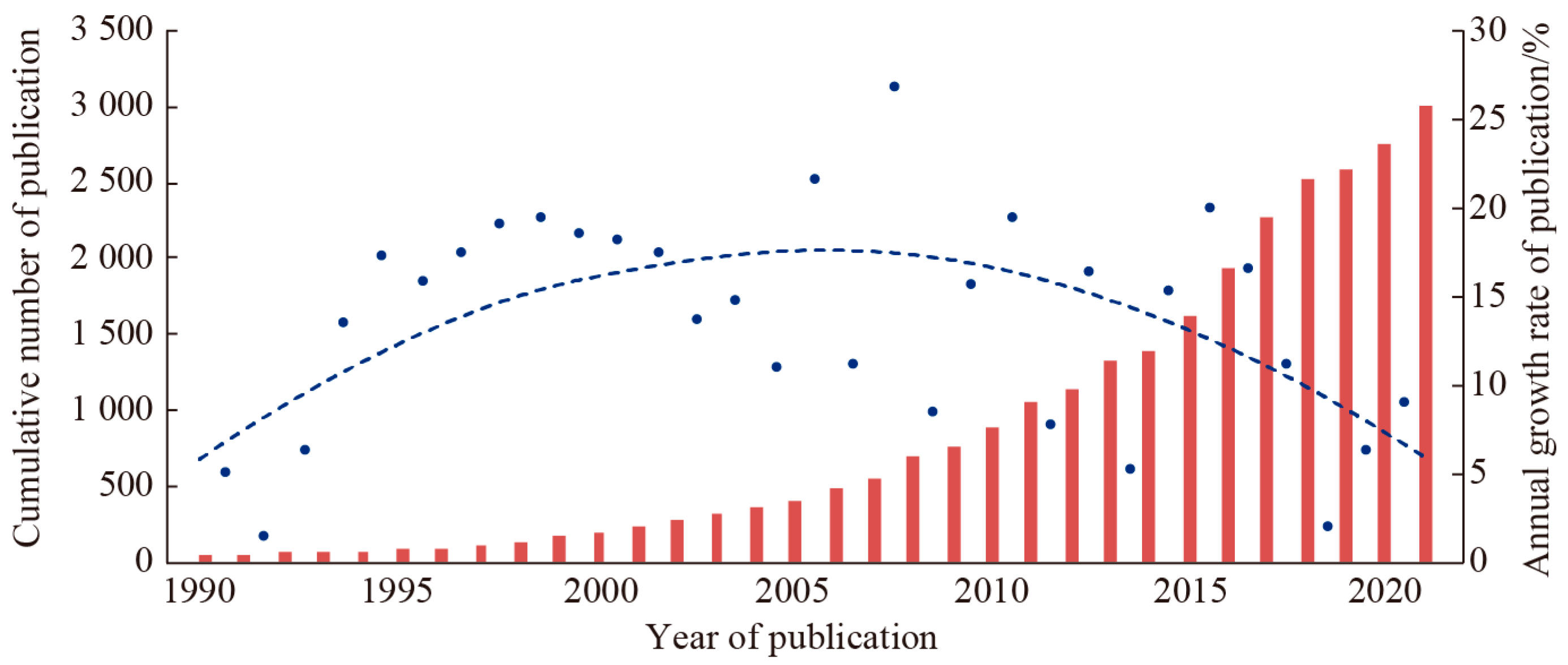
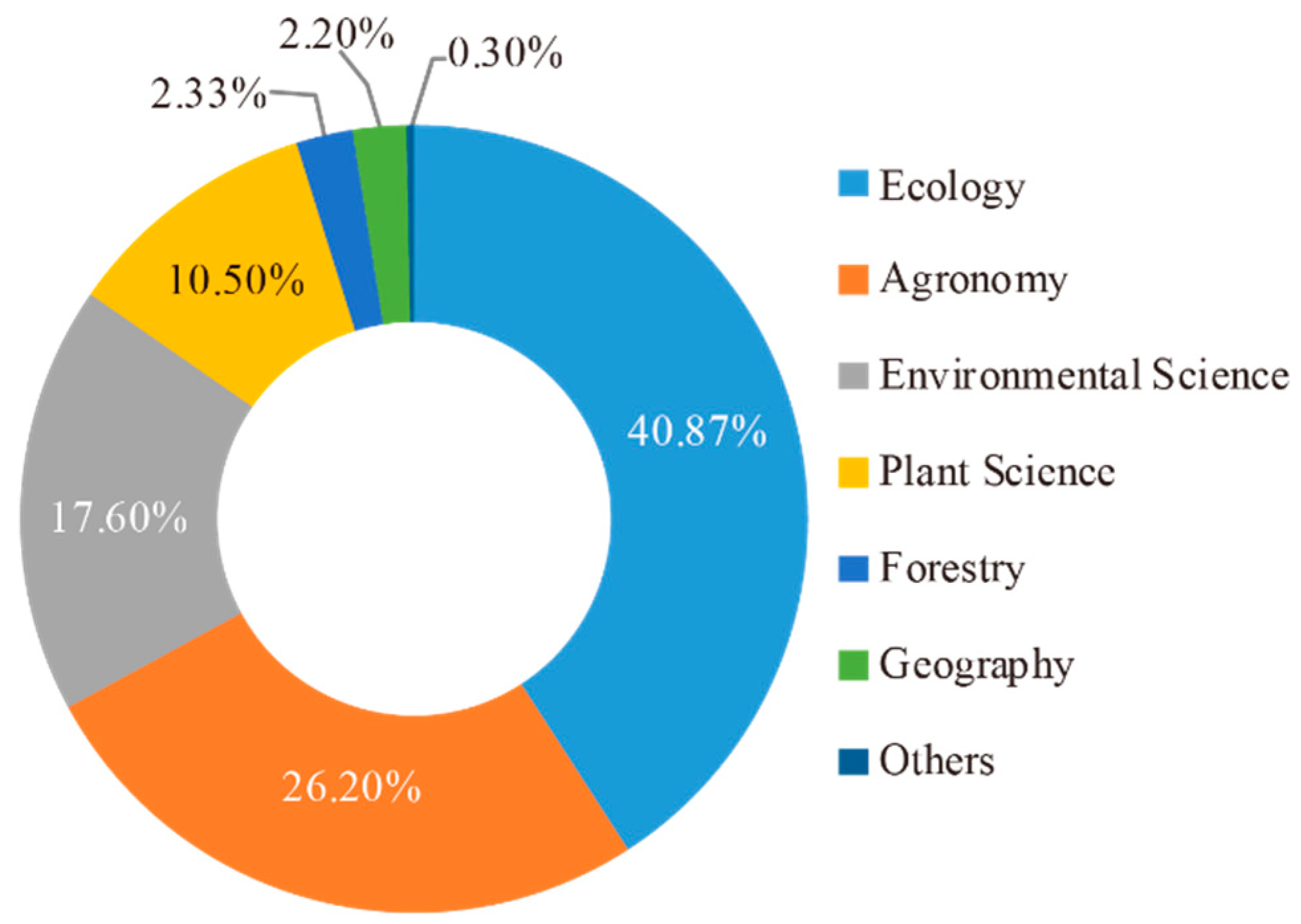
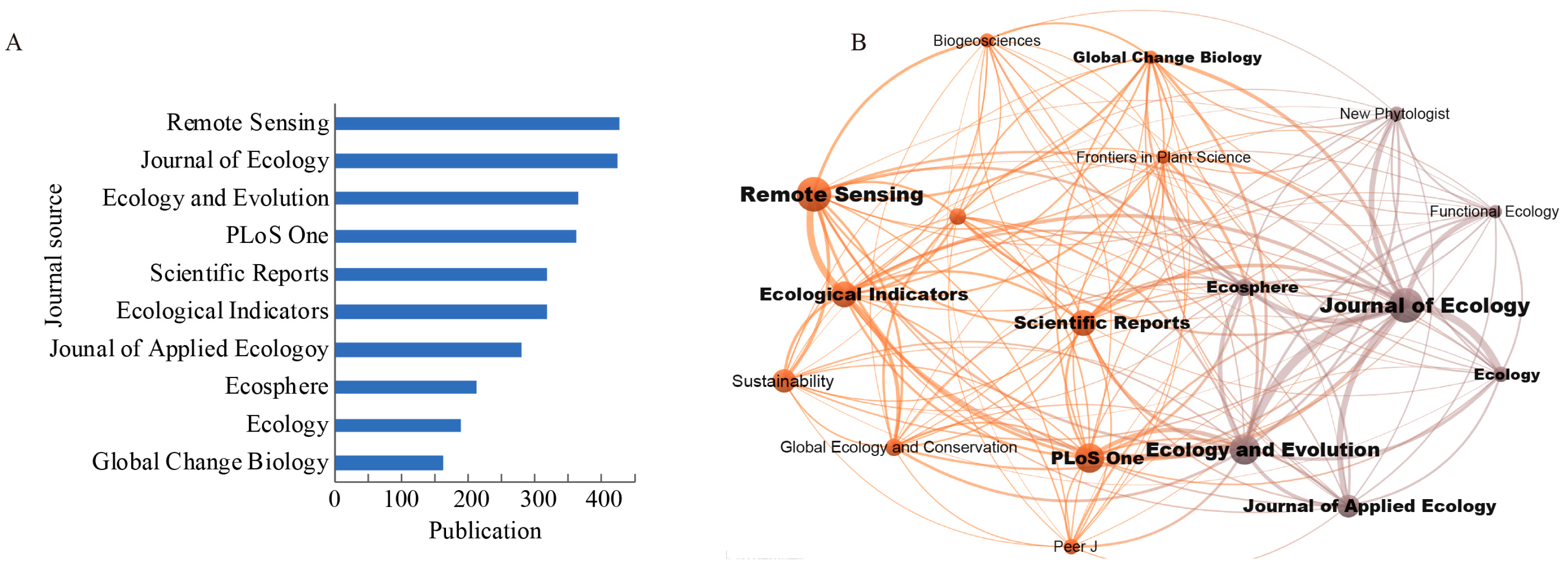
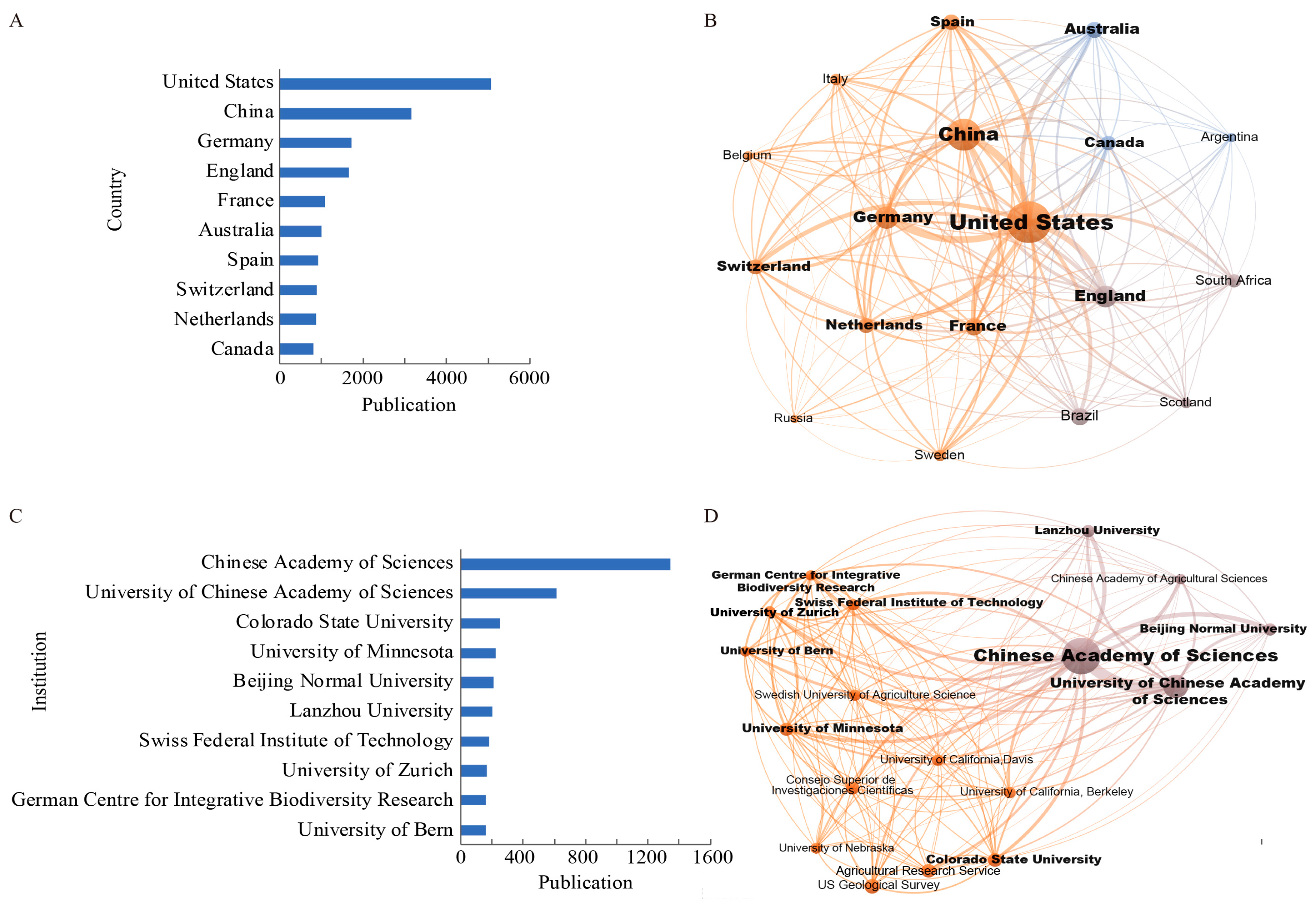
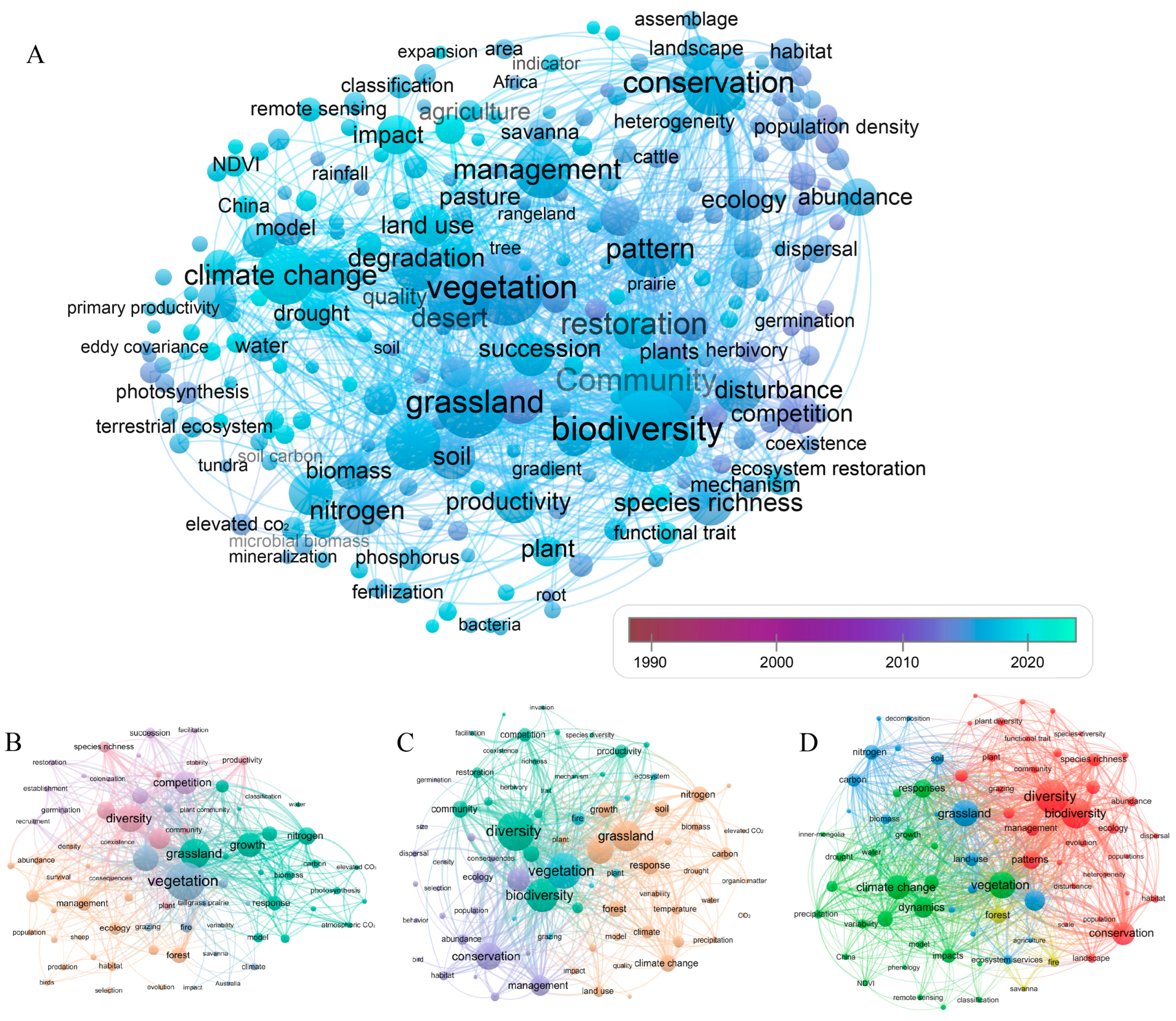
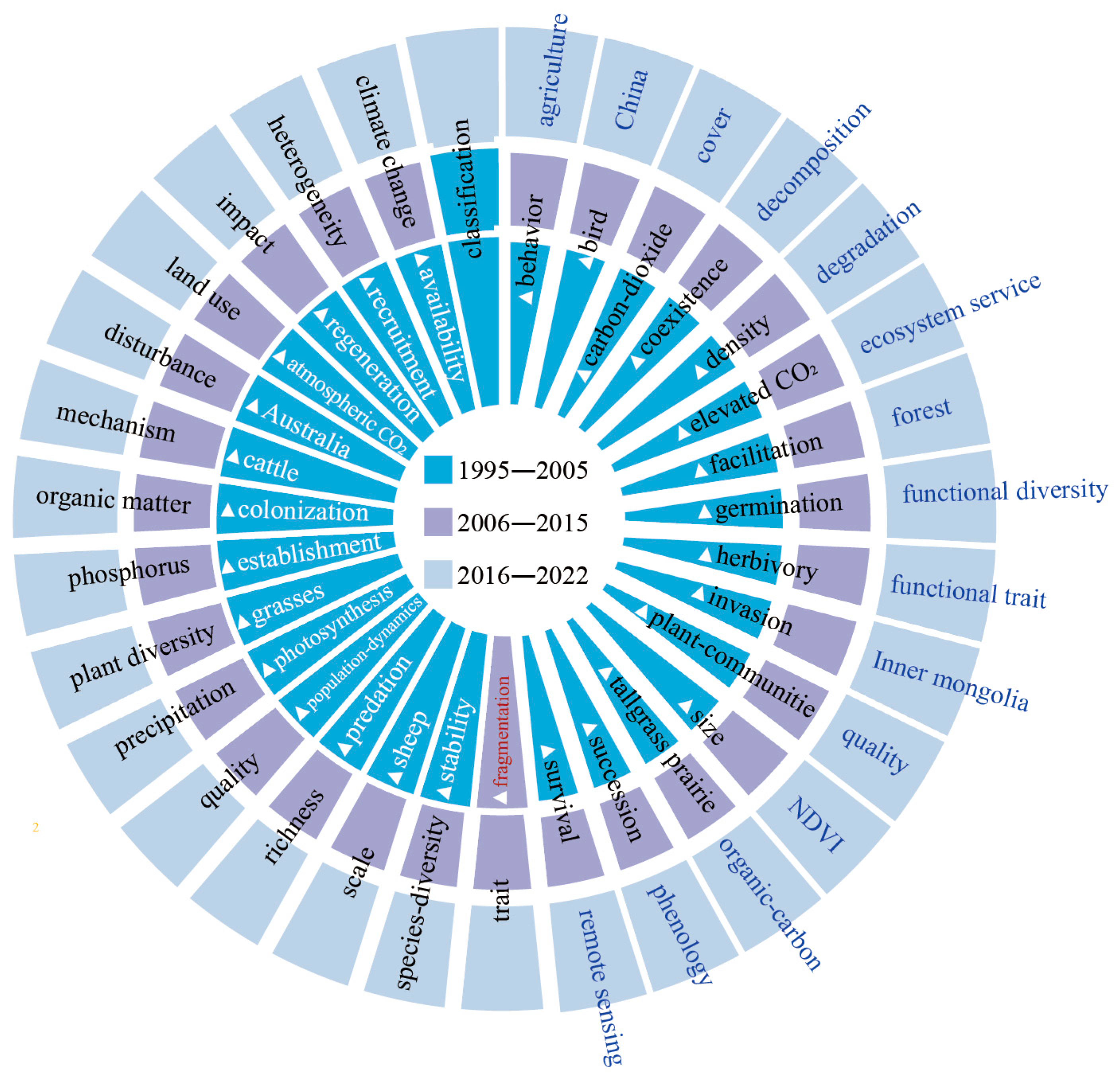
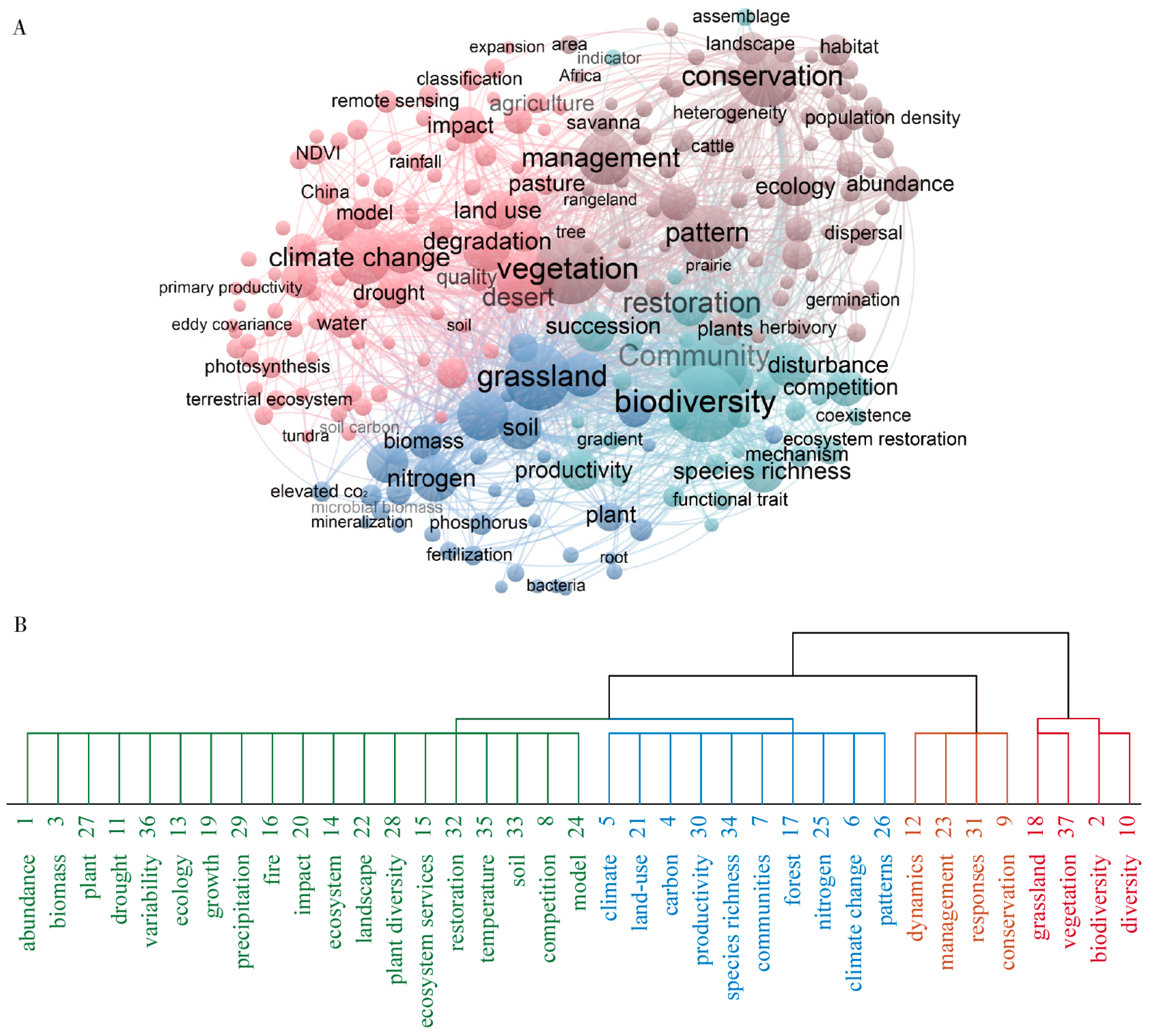

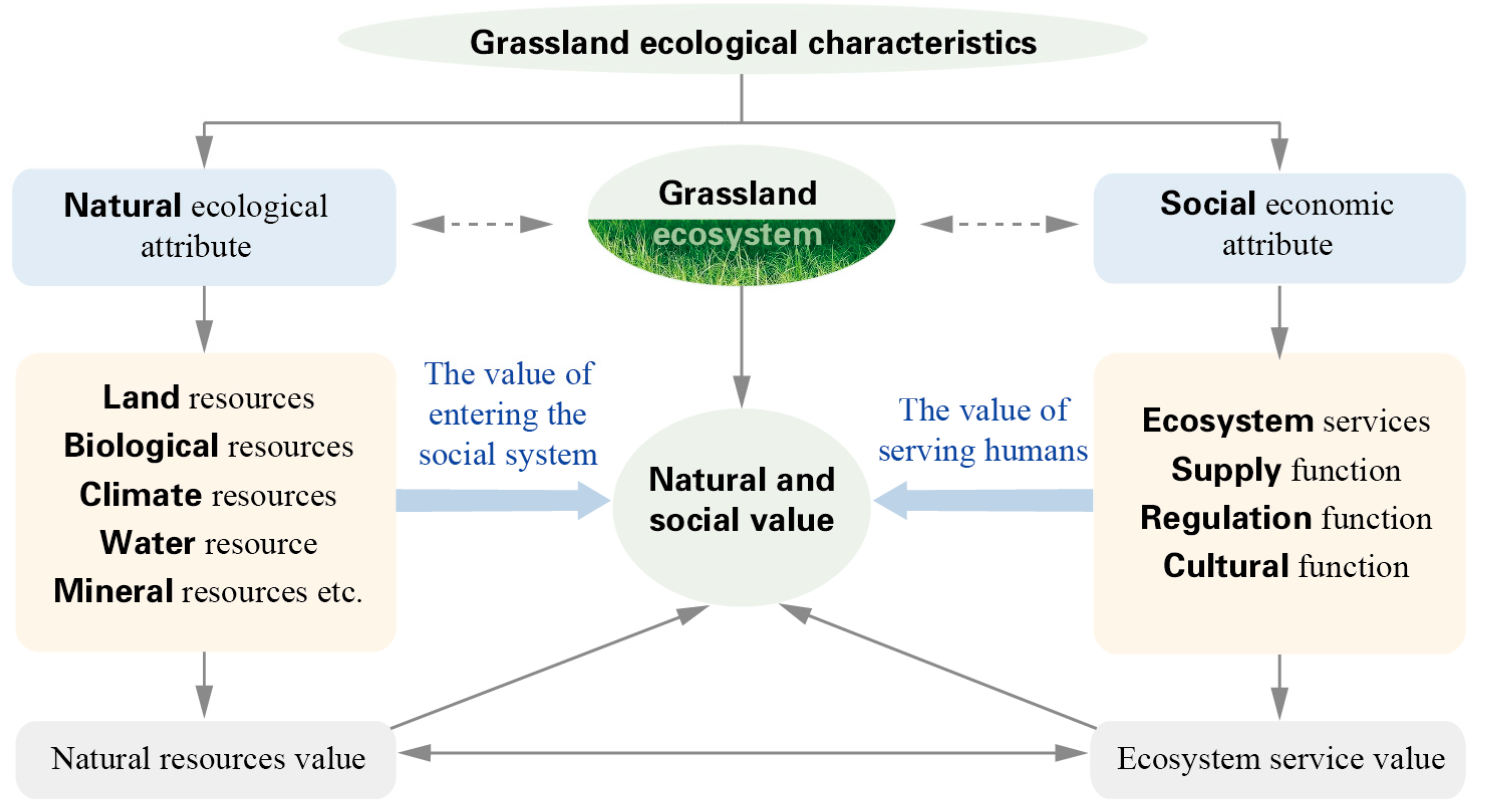
Disclaimer/Publisher’s Note: The statements, opinions and data contained in all publications are solely those of the individual author(s) and contributor(s) and not of MDPI and/or the editor(s). MDPI and/or the editor(s) disclaim responsibility for any injury to people or property resulting from any ideas, methods, instructions or products referred to in the content. |
© 2023 by the authors. Licensee MDPI, Basel, Switzerland. This article is an open access article distributed under the terms and conditions of the Creative Commons Attribution (CC BY) license (https://creativecommons.org/licenses/by/4.0/).
Share and Cite
Zhu, X.; Zheng, J.; An, Y.; Xin, X.; Xu, D.; Yan, R.; Xu, L.; Shen, B.; Hou, L. Grassland Ecosystem Progress: A Review and Bibliometric Analysis Based on Research Publication over the Last Three Decades. Agronomy 2023, 13, 614. https://doi.org/10.3390/agronomy13030614
Zhu X, Zheng J, An Y, Xin X, Xu D, Yan R, Xu L, Shen B, Hou L. Grassland Ecosystem Progress: A Review and Bibliometric Analysis Based on Research Publication over the Last Three Decades. Agronomy. 2023; 13(3):614. https://doi.org/10.3390/agronomy13030614
Chicago/Turabian StyleZhu, Xiaoyu, Jianhua Zheng, Yi An, Xiaoping Xin, Dawei Xu, Ruirui Yan, Lijun Xu, Beibei Shen, and Lulu Hou. 2023. "Grassland Ecosystem Progress: A Review and Bibliometric Analysis Based on Research Publication over the Last Three Decades" Agronomy 13, no. 3: 614. https://doi.org/10.3390/agronomy13030614
APA StyleZhu, X., Zheng, J., An, Y., Xin, X., Xu, D., Yan, R., Xu, L., Shen, B., & Hou, L. (2023). Grassland Ecosystem Progress: A Review and Bibliometric Analysis Based on Research Publication over the Last Three Decades. Agronomy, 13(3), 614. https://doi.org/10.3390/agronomy13030614


_Van_den_Pol-van_Dasselaar.png)







